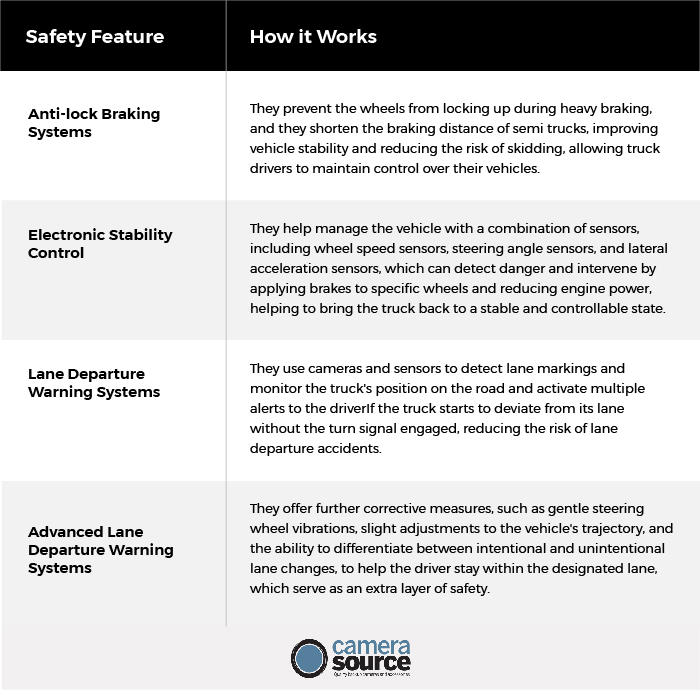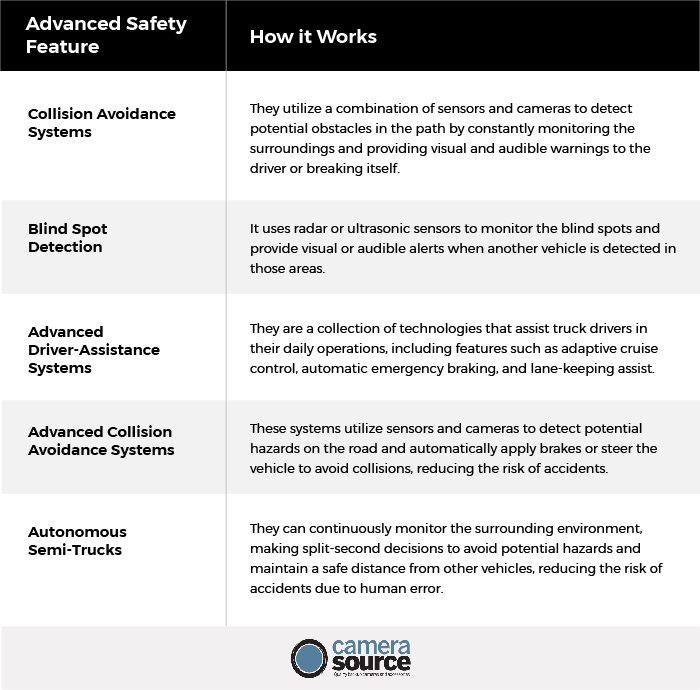Semi trucks, also known as tractor-trailers or big rigs, are a vital part of the transportation industry. These large vehicles transport goods across long distances, playing a significant role in the global supply chain.
However, due to their size and weight, semi trucks pose unique safety challenges on the road. Therefore, understanding and implementing essential safety features in these vehicles is of utmost importance to minimize accidents and protect both truck drivers and other road users.
So in this article we will dive into the importance of semi-truck safety features, the essential safety features any semi-truck should have, some advanced options, and how drive training is crucial for on-road safety.
The Importance of Semi-Truck Safety
Semi-trucks are responsible for transporting vast amounts of goods across the country. From food and medicine to industrial equipment, the transportation of these goods not only supports economic growth, but also sustains the well-being of individuals and communities.
Without semi-trucks we could face scenarios like empty grocery store shelves, hospitals without medications, and halted construction projects. That is why the safety features in semi-trucks are essential to preventing accidents that can have disastrous consequences.
While semi-trucks are a crucial component of the transportation industry, they are also involved in a significant number of accidents. According to the National Highway Traffic Safety Administration (NHTSA), in 2019 alone, there were over 4,000 fatalities in accidents involving large trucks.
These statistics highlight the urgency to prioritize safety enhancements in semi trucks and address the factors contributing to these accidents. There are various factors that contribute to semi-truck accidents, so let’s get into more detail to further clarify the importance of safety features.
The 3 Factors that Contribute to Semi-Truck Accidents
Safety features have been an evolutionary industry that has allowed drivers to prevent multiple accidents. But to better understand how they work in favor of semi-truck drivers, we need to get into the factors that contribute to accidents. So, let’s get into more detail.
Driver’s Fatigue
Long hours on the road, tight delivery schedules, and demanding work conditions can lead to exhaustion and impaired driving. To combat this issue, transportation companies and regulatory bodies are implementing stricter regulations on driving hours and mandatory rest periods for drivers. Additionally, the industry is investing in technology that monitors driver fatigue levels and alerts them when it's time to take a break.
Mechanical Failures
Mechanical failures, such as brake malfunctions or tire blowouts, can have catastrophic consequences on the road. To mitigate these risks, trucking companies are implementing rigorous inspection and maintenance programs, increasing the overall reliability and efficiency of the transportation system.
Collisions
Features such as collision avoidance systems, lane departure warnings, and electronic stability control are becoming standard in many new trucks. These technologies act as additional layers of protection, alerting drivers to potential dangers and assisting them in maintaining control of the vehicle.
Addressing the factors that contribute to semi-truck accidents requires a multi-faceted approach that involves implementing strict regulations, providing comprehensive driver training programs, and promoting regular vehicle maintenance. Let’s look at some of the safety features that have been implemented to avoid these problems.
The 4 Essential Safety Features in Modern Semi-Trucks
To improve safety and prevent accidents, modern semi trucks are equipped with various safety features, which aim to enhance control, stability, and visibility. Let's take a closer look at some of these essential safety features:

By providing timely warnings and assistance, these systems help keep the truck within its intended path, promoting safer and more controlled driving. Now let’s get into some slightly more advanced safety technology that is revolutionizing the trucking industry.
The 5 Advancements in Safety Technologies for Semi-Trucks
As technology continues to advance, semi trucks are benefiting from more sophisticated safety technologies. These advanced features are being incorporated into newer models to further improve safety standards and reduce accidents on the road, so let’s get into some examples.

The integration of these advanced safety technologies in semi trucks is a testament to the continuous efforts to improve road safety. As technology continues to evolve, we can expect even more innovative solutions to be implemented in the future, further enhancing the safety standards of the trucking industry.
The Impact of Regulatory Changes on Semi-Truck Safety
As safety remains a top priority, regulatory bodies continue to introduce and update regulations aimed at improving semi-truck safety. These regulations may involve stricter safety standards, mandatory safety features, or enhanced driver training requirements.
Adhering to these regulations ensures that semi trucks are equipped with the necessary safety features and that drivers receive the training needed to operate the vehicles safely. They also have the potential to drive innovation in the industry.
Manufacturers and trucking companies are constantly adapting to meet new safety standards, leading to the development of cutting-edge technologies and safety features. By embracing these changes, the industry as a whole can work towards creating a safer environment for both truck drivers and other road users.
The Role of Driver Training in Semi-Truck Safety
While the incorporation of advanced safety technologies significantly contributes to improving semi-truck safety, driver training remains a crucial component of overall safety measures, as this allows drivers to effectively utilize safety features and apply defensive driving techniques, minimizing the risk of accidents.
Professional driver training programs play a vital role in ensuring that semi-truck drivers are equipped with the necessary knowledge and skills to operate their vehicles safely. These programs focus on various aspects of truck driving, including:
- Defensive driving techniques
- Vehicle control
- The importance of proper rest, nutrition, and exercise
- And understanding safety features.
By teaching them how to anticipate potential hazards and react appropriately, these programs contribute to reducing accidents and promoting a culture of safety within the trucking industry. In addition to professional training, many trucking companies provide their drivers with ongoing safety training programs.
These programs keep drivers updated on the latest safety regulations, best practices, how to handle extreme weather conditions, and emerging technologies. Regular safety training not only reinforces the importance of safe driving but also ensures that drivers are familiar with the specific safety features and systems installed in their assigned vehicles.
Last Thoughts on Semi-Truck Safety Features
Semi-truck safety features play a vital role in safeguarding lives and preventing accidents on the road. With essential safety features such as ABS, ESC, and LDWS becoming standard and the integration of advanced technologies like collision avoidance systems and ADAS, the overall safety of semi trucks continues to improve.
Additionally, driver training programs and future developments, such as autonomous technology and regulatory changes, hold tremendous potential for further enhancing safety standards. As advancements continue, it is crucial for all stakeholders, including manufacturers, trucking companies, and drivers, to prioritize safety and embrace these innovations to create a safer future for everyone on the road.











